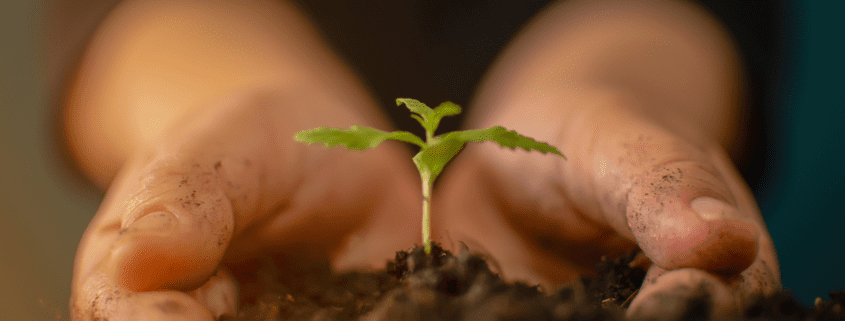Hemp and climate change: What’s the connection? Farmers are keen observers of the climate. Everything from changing weather patterns to water availability and soil quality directly impacts their ability to make a living. For this reason, climate change is already beginning to directly affect farmers. In 2020 alone, hemp farmers on the West Coast have dealt with an early and ferocious fire season. East Coast and Southern farmers are facing so many hurricanes, the normal naming convention ran through the complete alphabet by September. Even Midwest farmers aren’t safe, facing off against a fierce derecho in August. All this is to say that the climate is changing rapidly and farmers are on the front lines. Fortunately, hemp farmers may be able to step up and help fight climate change. How? By simply doing what they’re already doing: planting hemp.
Hemp is one of the most eco-friendly crops on the planet. It can absorb huge amounts of CO2, nourish the soil, and be used to create biodegradable and eco-friendly products. Why is hemp so good for the environment? Here are ten ways hemp will help save the world.
1. Hemp Absorbs Large Amounts of CO2
One of the most common greenhouse gasses driving climate change is carbon dioxide (CO2). CO2 is emitted by fossil fuels, livestock, and many industrial processes. Plants absorb CO2, which is why planting trees is one of the most popular ways to offset carbon emissions.
However, hemp can absorb carbon much more efficiently than trees. While it can take decades for newly planted trees to reach maturity, hemp can shoot up 13 feet in 100 days. Unsurprisingly, hemp can absorb more carbon per hectare than trees, making it an ideal carbon sink. Hemp can also grow just about anywhere, dramatically increasing the potential land that can be used to sequester carbon.
2. Hemp Nourishes the Soil
Many farmers have discovered that hemp can be a significant ally in nourishing and revitalizing their soil. The stalks and leaves of hemp plants are full of nutrients, which can be mixed back into the soil to bring overworked soil back to life. Planting hemp can also lower the need for farmers to add chemical fertilizers into their soil. Many farmers have added hemp into their crop rotation as a way to naturally nourish their fields between planting other cash crops. (It doesn’t hurt that hemp seed, fiber, and especially CBD flowers are cash crops in their own right.)
3. Hemp Prevents Erosion
Erosion is a natural process, where wind and water capture soil, often bringing it to nearby waterways. When large trees and plants are cleared and turned into fields, erosion can happen at a much faster rate. Erosion not only strips away topsoil, damaging fields and hurting crop yields, but it can also send chemical fertilizers and pesticides into waterways, hurting local wildlife and affecting drinking water.
Hemp can help prevent field erosion. Hemp roots grow deep and fast, helping to hold soil together and protecting it from the erosive effects of the elements. Hemp roots transfer nitrogen into the soil, which is a major component in chlorophyll.
4. Hemp Detoxifies Soil
Chemical leaks and nuclear disasters can turn soil toxic for generations, making that land unusable for planting, grazing, or anything else. A special class of plants is known as hyperaccumulators. According to the EcoSciences blog, hyperaccumulators “…have the capacity to absorb metals and other toxins from the soil by metabolizing it through their roots, where it is then transferred and stored in their stems and leaves.”
Hemp happens to be one of the best hyperaccumulators in the world. Hemp bioremediation is a popular technique of planting hemp in order to draw toxins out of the soil. Farmers have used hemp soil remediation to clean up fields after chemical leaks from nearby factories, but perhaps the most famous example is of farmers planting hemp (among other hyperaccumulators) around the blast zone of the Chernobyl nuclear power plant to begin rehabilitating the soil.
5. No Pesticides Needed
Hemp is naturally resistant to many of the diseases and pests that threaten other cash crops. Hemp farmers, therefore, don’t need to use pesticides or herbicides on their hemp fields. Chemical pesticides and herbicides can harm insect populations beyond what the chemical is meant to destroy. They also often make their way into local water sources, where they can affect the local wildlife or contaminate drinking water.
6. Less Water Needed to Make Fabric
Water is becoming an increasingly scarce resource, especially as more regions across the country and the world face record-setting droughts. At the same time, some of the most popular cash crops require high amounts of water, which puts a strain on communities. To put some perspective on this, one of the most water-hungry plants is cotton.
Hemp, while not officially a drought-tolerant plant, does not require nearly as much water as many other high-water crops. In fact, according to the Hemp Foundation, while every pound of cotton requires 1,440 gallons of water, hemp typically needs half that much. Hemp can also produce double the fiber of cotton per acre. Switching to hemp cloth from cotton can help farmers better manage their water supply and save money on a resource that’s only going to become more expensive. (Learn more about hemp field irrigation to see which irrigation systems are the most efficient.)
7. Hemp Paper Can Eliminate Polluting Paper Processes
Cutting down trees for paper can eliminate forests, disrupting ecosystems and putting more carbon into the air. Even as more paper companies switch to regenerative forest management, the process of making paper from wood pulp is extremely dirty. Wood pulp must be bleached with chlorine (which releases a toxic substance called dioxin) and is often mixed with binders that release formaldehyde. In contrast, hemp pulp doesn’t need to be bleached and can be made with soy-based binders, according to HempBenefits.org.
Hemp paper is also of higher quality than paper made from trees. It’s stronger, thicker, and more durable. No wonder the vast majority of paper was made from hemp in America’s early history. (Why did we switch to tree-made paper? It’s a long story.)
8. Hemp Can Help Reduce Plastic Waste
We are beginning to recognize more and more that single-use plastic is choking our world. Every year, eight million metric tons of plastic waste finds its way into the ocean, killing seabirds and ending up in the stomachs of the fish that eventually land on our dinner plates. Hemp bioplastic is an alternative to plastics derived from petrochemicals. Hemp bioplastics not only eliminate the need to create more plastics from oil, but it is also fully biodegradable, unlike traditional plastic, which can take 450 years or more to break down.
9. Hemp Can Be Used in Building Materials
The building sector (buildings and construction) is one of the biggest polluters on the planet, contributing to 36% of annual greenhouse gas emissions. Hemp-derived building materials can cut down on the carbon emissions of the construction industry as well as promote more energy efficiency within homes.
Hemp can be used to make fiberboards that are stronger and lighter than wood, as well as soundproofing and insulating materials. It can replace wood and concrete and offer better thermal insulation, which will allow homeowners to use less energy to heat and cool their homes. The insulating power of hemp-derived materials will only become more important as summers become hotter and winters become colder in the future.
10. Hemp Biofuels
The world is hungry for energy, using an estimated 575 quadrillion Btu of energy in 2015. (that’s a lot.) However, many of our top energy sources, including petroleum and coal, contribute to climate change and degrade the environment.
Hemp offers a clean energy alternative. Oils and fats extracted from hemp seeds can be used to make biodiesel. After a few more processing steps, the hemp biodiesel can actually go into a car engine to fuel a car. In fact, according to the site Hemp Benefits, one acre of hemp yields 1,000 gallons or 3,785 liters of fuel.
According to the Ministry of Hemp, hemp can also be turned into ethanol, which is traditionally derived from food crops, like corn and barley. Given that hemp can grow quickly in nearly any environment and requires less water than many other crops, hemp-derived ethanol can also be a sustainable alternative to traditional ethanol.
Considering that California’s governor recently announced that all new gasoline-powered cars would be banned in California by 2035, car manufacturers may want to start looking to hemp to fuel America’s next vehicle fleet.
Is Hemp the Solution to Climate Change?
Now that you’ve learned about hemp and climate change, do you believe hemp will help save the world? Hemp can certainly help provide more eco-friendly materials in a variety of industries, nourish and protect the soil, and sequester a lot of carbon, but hemp can’t save the world alone. Hemp is only one of many tools we can deploy to transition away from fossil fuels and other pollutants. Farmers have a strong role to play in the battle against climate change, as they are some of the most affected people when temperatures rise and the storms come. Hemp can be a highly lucrative crop, which is why many farmers initially decide to give it a try, but perhaps its climate-combatting credentials will also be a decisive factor in farmers choosing to grow hemp.
Ready to try growing hemp? Contact us today.



